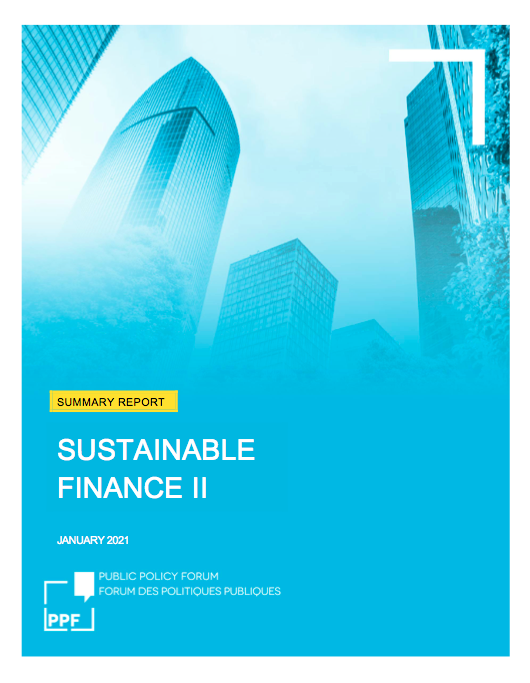
Sustainable Finance 2
Roundtable Series SummaryBuilding on the Expert Panel Report of 2019, Sustainable Finance 2 convened four virtual roundtables with experts across Canada
EXECUTIVE SUMMARY
A policy-maker or a policy-taker—which is Canada to become? Canada has been trailing behind global developments in sustainable finance, though serious work, particularly in the private and not-for-profit sectors, is underway to develop and implement plans that support a sustainable outcome. If the sustainable finance market is to expand, Canada must provide comprehensive data and information on the impact of climate change for those markets. It must also offer policy and regulatory certainty for both providers and users, and ensure that financial institutions can earn a return on investment.
Sustainable Finance 2 makes recommendations in four key areas:
Climate Data and Analytics highlights the need for clear, comprehensive, high-quality information and analysis on the impacts of climate change for the financial markets. It recommends the creation of a Canadian Centre for Climate Information and Analytics as a trusted single-stop source for authoritative climate data and information relevant to sustainable finance. Amplifying research available from Statistics Canada, complementary information will be required from major institutional investors, insurers, financial institutions, business associations, sectoral stakeholders, CPAs, stock exchanges, the federal government, provinces and cities, etc.
Developing a Capital Mobilization Plan advises mapping Canada’s long-term path to a low-emissions, climate-smart economy sector by sector with an associated capital plan. Spurred by the economic imperative for Canada to mobilize capital as part of an immediate post-COVID economic recovery, Canada has a historic opportunity to align its goals for growth with its low-carbon transitions. In doing so, Canada can create sustainable jobs, build resilient communities, and foster innovations that drive economic growth and ingenuity. The panelists agreed that the private sector is driving the green finance agenda, not because it’s been regulated by policymakers around the world, but because market participants think it makes good economic sense.
Developing a Transition Taxonomy and Expanding the Green Fixed Income Market identifies the need for a classification system – or taxonomy – to create a common language for sustainable finance. The initial focus is to define transition finance in the Canadian market with issuers, underwriters and investors sharing their experience and insight into how they have incorporated and applied taxonomy into their business models. Despite being a resource-based economy with key GHG-emitting sectors, Canada is also a leader in developing the technological solutions needed to reach net zero.
Supporting the Oil and Gas Sector Through Sustainable Finance focuses on the energy sector as a major employer, innovator, and exporter, but also as one of Canada’s largest sources of GHG emissions from production to usage. The investment community has an appetite for involvement in a low-carbon transition in Canada’s oil and gas sector, but the competitive risk-return profile must be presented through greater transparency. Investors need detailed disclosures that outline de-carbonization targets and implementation plans, together with a diversification plan for growth beyond combustible fossil fuels, that looks more comprehensively at Canada’s energy sector. Canada has a very small window of time to make decisions on transition financing for the oil and gas sector. It has the opportunity to be a leader in the global low-carbon transition by de-carbonizing its energy sector, fostering innovation and exporting our solutions to support the de-carbonization of other resource-dependent countries: by leveraging existing foundation work; developing a transition taxonomy; creating a regulatory framework that provides incentives for capital investments; scaling clean tech innovations; and fostering and sustaining partnerships between government and the private sector. Canada can achieve its 2030 and 2050 climate goals while becoming a global leader on the pathway to net-zero.









